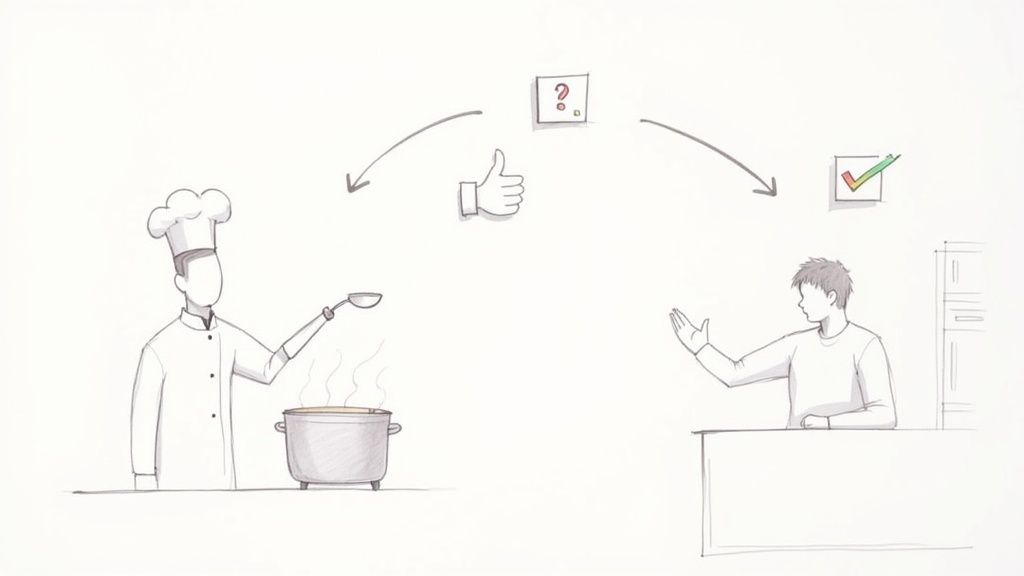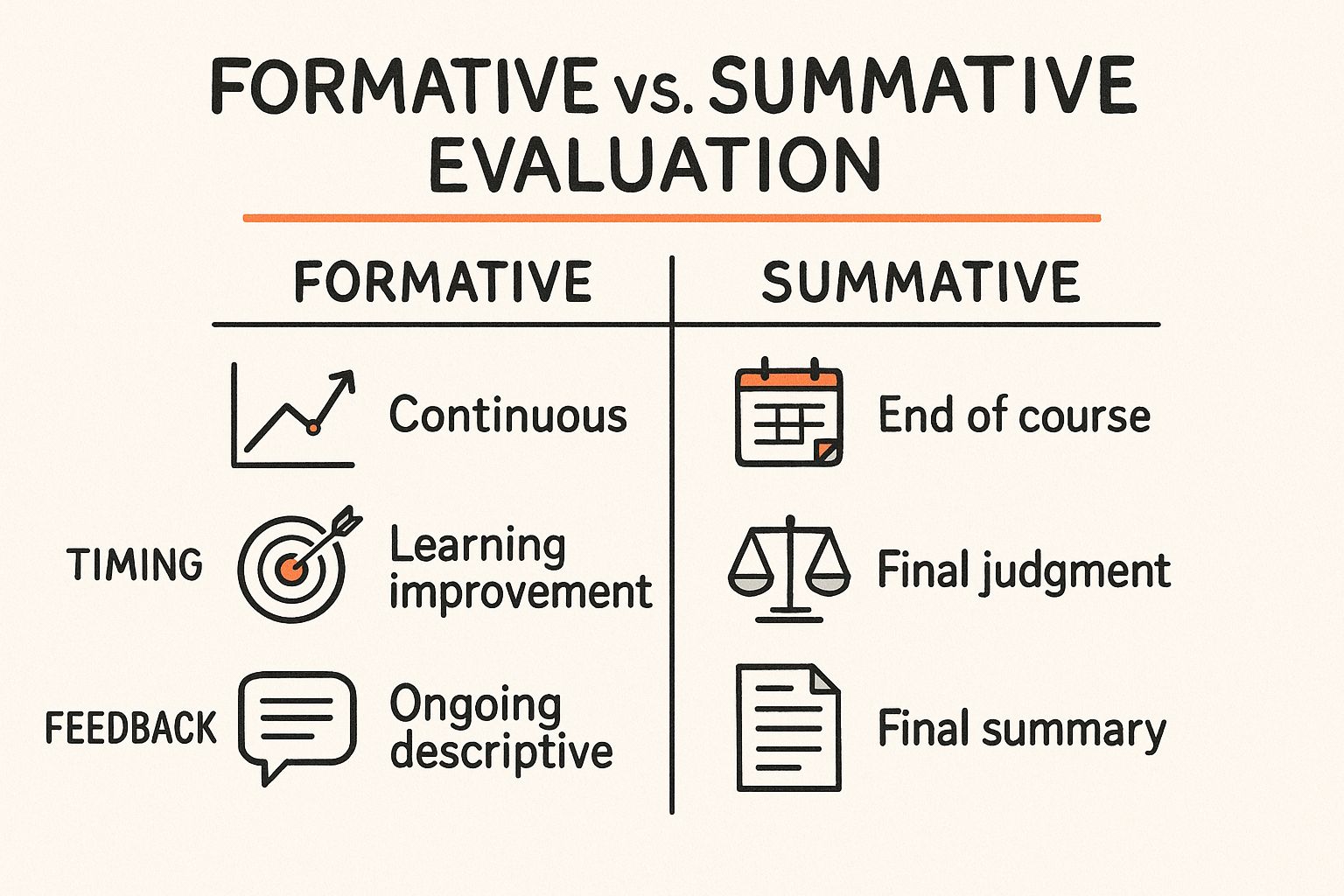
Ever heard the saying, "When the chef tastes the soup, that's formative; when the customer tastes the soup, that's summative"? That little analogy gets right to the heart of formative evaluation.
It’s all about checking in on learning while it’s happening to provide feedback that can actually be used. Think of it less like a final exam and more like a coach giving pointers from the sidelines during a game.

At its core, formative evaluation is assessment for learning, not just of learning. It’s not about slapping a grade on something and moving on. Instead, it’s a living, breathing part of the learning process itself—a continuous conversation between the instructor and the learner. The whole point is to guide and shape the learning journey while it's still underway.
These are usually low-stakes activities with little to no point value, like quick quizzes, exit tickets, or turning in a rough draft. The goal is to spot misunderstandings and make corrections in the moment, not to deliver a final verdict. You can dig deeper into the academic side of this on Wikipedia's formative assessment page.
So, what makes an evaluation "formative"? It really comes down to a few key ingredients that create a supportive and effective learning loop.
Formative evaluation is the instructional designer's compass. It provides real-time directional feedback, ensuring that both the course and the learners are heading toward the intended destination without getting lost along the way.
Ultimately, this process makes sure everyone is on the right track before you jump into the next big concept. It's a cornerstone of modern instructional design, especially now that we have tools like a Learning Management System (LMS) or Learning Experience Platform (LXP) and authoring software like the Articulate Suite or Adobe Captivate that make gathering this kind of in-the-moment feedback easier than ever.
To really get what formative evaluation is all about, it helps to see it side-by-side with its counterpart: summative evaluation.
Think of it this way: formative evaluation is the chef tasting the soup while it's still cooking. Is it missing something? A little more salt? Too much thyme? The goal is to make adjustments on the fly to get the best possible result.
Summative evaluation, on the other hand, is the customer tasting the finished soup and deciding whether they'll order it again. The cooking is done; this is the final judgment.
Formative evaluation is all about improvement and development. It happens during the learning or training process. It’s like a friendly check-in—a quick poll, a draft review, or a low-stakes quiz—designed to see what’s landing and what’s not. The feedback is immediate and focused on growth, not grades.
Summative evaluation is the opposite. It’s the final exam, the big project, the certification test at the very end of a program. It’s designed to measure the final outcome and answer one big question: "Did the learner master the material?"
This image helps visualize the core differences between the two.

As you can see, it all boils down to timing and purpose. Are you trying to improve the process, or are you measuring the final result?
Let's break it down even further with a quick comparison table. This can help you decide which tool to pull out of your toolbox at any given time.
Ultimately, a smart training strategy uses a healthy mix of both. The workout check-ins (formative) ensure you're ready for the final competition (summative).
Knowing when to use each is a game-changer for anyone designing a training program. If you only rely on a big final exam, you might not realize your learners were lost back in week two.
By weaving in formative check-ins, you can catch misunderstandings early and make small adjustments along the way. This builds a much stronger foundation, making it far more likely that everyone will succeed when the summative evaluation comes around.
Here’s a simple way to remember it: Summative evaluation proves; formative evaluation improves.
Both are critical, but getting them mixed up is a recipe for trouble. For example, in a step-by-step process like the one we outline in our guide to the ADDIE model for training, you use formative checks at each stage before moving on.
Think of it as steering a ship. The formative checks are the small, frequent adjustments to the rudder that keep you on course. The summative evaluation is what confirms you’ve successfully reached your destination. You really can't have one without the other.

Okay, so we know what formative evaluation is. But the real question is, why should you care about it in a corporate setting? Let's get to the heart of it. This isn't just some dusty academic concept; it's a powerful tool that has a direct impact on how well your training programs actually work.
Think of it as an early-warning system. It helps you, the instructional designer, spot where employees are getting confused or losing focus before it turns into a major roadblock. By collecting feedback early and often, you create a training environment that actually responds to your team's needs in the moment. It transforms a one-way lecture into a dynamic conversation.
One of the most immediate benefits is how it changes the whole vibe of learning. We've all been there—staring down a high-stakes final exam that makes you sweat. That kind of pressure makes people focus on memorizing just enough to pass, not on actually learning.
Formative check-ins are low-stakes, which takes all that pressure off.
Formative evaluation creates a safe space to fail, which is where real learning happens. It sends a clear message: "It's okay if you don't get this yet. We're going to figure it out together."
This kind of supportive environment encourages people to take chances and really grapple with the material. As they get helpful feedback and watch themselves improve, their confidence soars. That leads to much better retention and a team that’s actually excited about learning.
At the end of the day, any training program has to deliver real value to the business. This is where formative evaluation really proves its worth. When you use feedback to make smart adjustments on the fly, you're building a much stronger program.
This nimble approach means your training is far more likely to create skilled, confident employees who can immediately use what they've learned on the job. And that’s how you get a direct, positive impact on the bottom line.
The fundamental idea of formative evaluation—checking in on learning as it happens—is timeless. What has changed is the incredible set of tools we now have at our fingertips.
Gone are the days of relying solely on classroom observation and paper-and-pencil quizzes. Today's instructional designers can weave feedback loops directly into the learning experience itself, making evaluation a seamless part of the process, not a separate event.
Think about a modern Learning Management System (LMS) or a Learning Experience Platform (LXP). These aren't just digital filing cabinets for courses anymore. They are living, breathing environments packed with built-in tools like instant polls, quick-fire quizzes, and active discussion forums. Each one is a mini-checkpoint, giving you a real-time pulse on how well learners are grasping the material.
The real power comes alive when you blend solid instructional design principles with the right tech. It’s one thing to know you need to check for understanding, but it’s a whole different ballgame to build an interactive scenario that does it without feeling like a test.
This is where authoring tools like the Articulate Suite or Adobe Captivate come in. They let you move way beyond basic multiple-choice questions.
The dashboard for a tool like Articulate 360 shows how all these different applications work together to build rich learning experiences.
This highlights that modern course creation isn't about a single program. It's an entire ecosystem built to create diverse and interactive formative checks.
Two huge trends are pushing formative evaluation even further: AI and microlearning.
Microlearning is a natural fit. Think about it: a short, five-minute video followed by a one- or two-question quiz. It's a quick, low-stakes way to reinforce a key idea and get an instant read on comprehension. This bite-sized approach gives you a constant stream of feedback without ever feeling like you're overwhelming the learner.
AI, on the other hand, is bringing a whole new level of personalization to the table. AI-powered platforms can analyze a learner's responses in real-time and pinpoint exactly where they're struggling. From there, the system can automatically serve up a quick review article or suggest a different activity to close that knowledge gap. This creates a truly adaptive learning path, turning formative evaluation into a personal guide for every single learner.

Alright, let's talk about actually doing this. The good news is you don’t need to tear down your entire design process. Think of it less like a massive project and more like weaving a continuous feedback loop right into the DNA of your training.
The secret is to stop thinking of evaluation as a final exam. Instead, see it as a series of casual, helpful conversations you have with your learners all along the way.
It all starts with your learning objectives. Before you can check if someone "gets it," you have to be crystal clear on what "it" is. Nailing down your objectives gives every poll, quiz, or activity a real purpose.
The best method really comes down to your content and who you're teaching. Don't feel locked into old-school quizzes! There are so many creative ways to gather feedback these days.
Here are a few of my go-to's:
The trick is to match the tool to the task. If you're checking for basic facts, a poll works beautifully. If you're teaching a complex skill, a hands-on scenario will tell you so much more.
Collecting data is just the first step. The real magic happens when you use that information to make smart adjustments on the fly. After all, the whole point is to actively guide how the program unfolds in real time.
If you see that 70% of your group got a poll question wrong, that’s not a failure—it's a bright, flashing sign telling you exactly where to focus next.
It's all about creating a culture where feedback feels helpful, not judgmental. When you frame these check-ins as opportunities to learn and grow, people are far more likely to give you honest, useful input.
Ultimately, you know you've succeeded when feedback becomes a totally normal and expected part of the learning journey. When you blend these check-ins with proven adult learning techniques, you create programs that don't just talk at people, but truly respond to their needs.
Once you get the hang of formative evaluation in theory, a few practical questions always pop up. It’s one thing to know the definition, but it's another thing entirely to figure out how it actually works in the real world.
Let's tackle some of the most common sticking points so you can start using these ideas with confidence.
This is a big one. And the short answer is: you probably shouldn't.
The whole idea behind formative evaluation is to create a safe, low-stakes space for people to learn and grow. Slapping a grade on it can bring back all that test-taking anxiety, shifting the focus from "Let me try to figure this out" to "What's the right answer to get a good score?"
If you absolutely must assign points, tie them to participation or effort, not correctness. This keeps the focus on learning, encouraging people to take risks and make mistakes without fear of penalty.
There’s no single right answer here—it’s all about rhythm and consistency. You want these check-ins to feel like a natural part of the learning process, not a surprise pop quiz.
Think of it this way:
The key is to create a continuous feedback loop. It turns evaluation from a one-time event into an ongoing conversation.
This is a great question, and the distinction is subtle but super important.
Think of formative evaluation as the whole activity—it’s the structured method you use to see where learners are at. This could be a short quiz, an observation, or even reviewing a first draft created in a tool like Articulate Storyline.
Feedback is the specific, helpful information you give the learner as a result of that activity.
So, you conduct a formative evaluation to gather the insights you need to give truly great feedback. One is the process, the other is the result.
At Relevant Training, we specialize in developing engaging eLearning content that puts these principles into practice for small and medium-sized businesses. Explore how we can help you build more effective training programs.